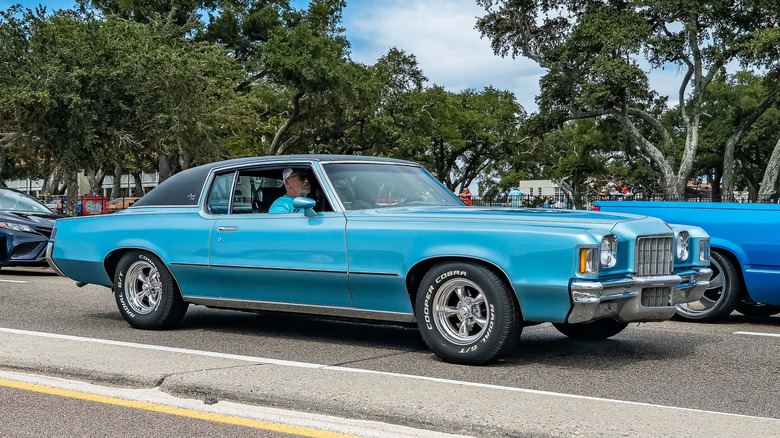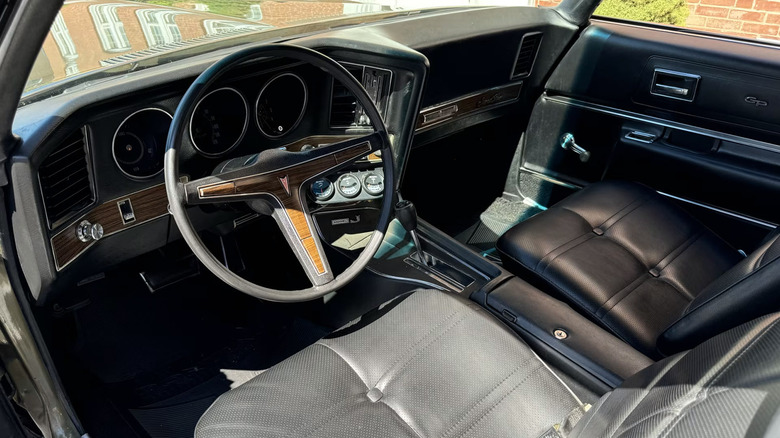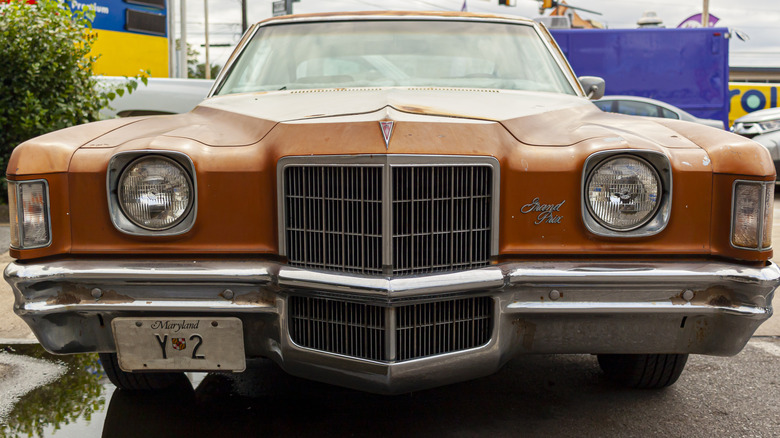1972 Pontiac Grand Prix: Everything You Need To Know About This Classic Car
Though the Pontiac brand has now been gone for over 15 years, its vehicles continue to be enjoyed and celebrated by enthusiasts and classic car fans of all types. When it comes to Pontiac's iconic models, the high-performance GTO and Firebird/Trans Am, not surprisingly, will top most lists, but not far behind those two cars is another Pontiac model that had an even longer production run, the Grand Prix.
The Pontiac Grand Prix was in production from 1962 until 2008 and underwent several different evolutions during those decades. From the early '60s Grand Prixs and their optional and innovative Pontiac eight-lug wheels, to the supercharged Grand Prix GTPs of the '90s and 2000s, there are many memorable and sought-after versions of this car, but the most influential version Grand Prix may have been the 1969-1972 model, which blended the GTO's performance cred with a heavy helping of luxury.
The 1972 Grand Prix represented the final model year of this generation Grand Prix, and was originally planned to be the first year of a new-generation Grand Prix, rather than the final iteration of the "long hood, short deck" Grand Prix. Let's break down what made the '72 (and the rest of the Grand Prixs from this era) so special.
Luxury meets performance
From its debut in 1962 up until 1968, the Pontiac Grand Prix was a stylish two-door coupe (and for just one year, a convertible) that was based on the same General Motors full-size B-body platform used by the Pontiac Bonneville and Catalina. The vastly different 1969 Grand Prix was the brainchild of legendary (and later infamous) engineer John Z. Delorean, who opted to move the Grand Prix onto a version of the mid-sized A-body platform used by the Pontiac Le Mans and GTO.
The move to the new platform not only gave the new Grand Prix a more sporting driving experience, it allowed for exotic new styling both inside and out. With its long-hood, short deck proportion, and beaked grille, many, including Pontiac itself, viewed the new Grand Prix as a modern iteration of the classic Duesenbergs of the 1920s and '30s. The car even used Duesenberg-inspired trim names, Model J and Model SJ. Inside, the '69-'72 Grand Prix was defined by its stylish, fighter-plane cockpit with instruments that angled toward the driver.
Combine all of that with some Pontiac's peak muscle car era engines, including the 428 HO and later the 455 cubic-inch V8, and you have a pretty enticing combination. In fact, the redesigned Grand Prix caused such a stir that Pontiac's GM siblings Chevrolet and Oldsmobile quickly responded for 1970 with new mid-sized "personal luxury coupes" of their own in the form of the Monte Carlo and Cutlass Supreme.
1972, the end of an era
For the 1971 model year, the Grand Prix got a thorough exterior styling refresh, with the most distinct change coming up front, where the quad headlights were replaced with dual headlights. The 1972 Grand Prix would look nearly identical to the '71, apart from small differences in the grille design. Interestingly, it was originally planned that the '72 Grand Prix would be an all-new model, but a strike at General Motors in late 1970 delayed things, making the '72 model a carryover from the previous year. Instead, 1973 would be the first model year for the fully redesigned Grand Prix.
By 1972, the engine options in the Grand Prix were either a standard 400-cubic-inch V8 or an optional 455 V8, though, as with other Detroit performance cars, horsepower numbers had decreased from earlier years. Finally, you can't talk about the early '70s Pontiac Grand Prix without mentioning the rare Hurst SSJ models, with their unique paint jobs, sunroofs, and landau tops. Though not the wildest or most well-known of Hurst's various street and drag strip creations, thanks to its low production numbers, the Hurst Grand Prix SSJ is a popular collector machine today. And of the Hurst Grand Prix family, the 1972 model year is likely rarest, with only 60 examples known to be built, though some say actual production numbers were higher.


